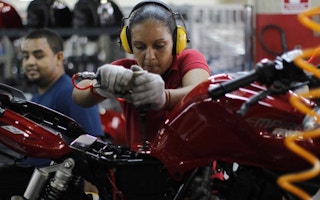* Any views expressed in this article are those of the author and not of Thomson Reuters Foundation.
In an era of rapidly changing economies—clean energy, cryptocurrencies, and emerging markets—countries are missing out on a smart and simple solution, with a massive return on investment: women.
This missed opportunity is costing us. The World Bank estimates that nations leave $160 trillion on the table each year by keeping women from fully participating in national economies. Three factors drive these losses: women participate at lower rates in the labour force, work fewer hours, and are generally paid less than men.
This problem will not solve itself. On December 18, the World Economic Forum (WEF) reported that progress on gender equality is stagnating as women’s participation in the workforce and politics has stalled. As global leaders prepare for the next WEF Annual Meeting, it’s time to flip this script.
“
Investing in gender equality isn’t just the right and fair thing to do, it pays off for everyone.
The theme of Davos 2019 is Globalisation 4.0, a catch-all term for global shifts from the economy to the environment. Conversations will focus on advances in technology, increased global cooperation, migration, and climate change. These forces bring mounting challenges, but also opportunities that those at the epicentre of power must harness for good.
One key to Globalisation 4.0 bringing about positive change is honing in on gender equality. Investing in gender equality isn’t just the right and fair thing to do, it pays off for everyone.
A 2015 McKinsey analysis of 95 countries estimated that if all countries looked more like the best-case scenarios—where women participate in economies identically to men—it would add as much as $28 trillion to GDPs by 2025. That’s 26 per cent added to the global economy, not exactly pocket change.
Of course, to see these gains, we must lift the barriers women face entering, staying, and advancing in the workforce. The McKinsey report notes that violence against women, lack of access to reproductive health care, and unequal access to education, financial services and technology all prevent women from seeking employment opportunities at the same rate as men.
Barriers exist even in emerging fields and are quite dramatic in the tech space. Analysis by WEF and LinkedIn found that women represent only 22 per cent of the rapidly growing AI workforce. This gap is three times larger than disparities in other talent fields and fuels gender bias in the very tools built by the industry.
Addressing all of these disparities should be at the top of the agenda at Davos. Here’s what leaders can do:
-
Invest in a gender-equal workplace
We need creative solutions to offer women a fair shot. For example, women represent half of the managers at Procter & Gamble and one-third of the company’s leadership. These figures are no accident—they were achieved through deliberate work and bold targets set to ensure that women have the same opportunity as men to take on key roles. The company also offers gender equality training for men to tackle unconscious bias.
Similarly, the software company Pipeline is using AI to eliminate the glass ceiling. The AI analyses employee reviews, raises and promotions to ensure that gender isn’t a limiting factor in career advancement and that everyone is afforded the same opportunities.
-
Be part of the global solution
The challenges women face aren’t limited to the workplace. Our solutions need to reflect this. For example, Royal Philips has partnered with UNFPA to see how the company can apply technology—from mHealth to electronic data collection—to reach more women and girls with pregnancy care in countries like Kenya and Congo-Brazzaville.
As part of its Unstereotype Alliance, Unilever, UN Women and partners launched an effort to rid their advertising of gender stereotypes. The company has also partnered with Oxfam to tackle the gender stereotypes that allocate the bulk of family chores and community unpaid labour to women.
-
Bring the conversation to the main stage
Issues related to women’s participation in the economy and society at large shouldn’t be relegated to side events. At meetings like Davos, we’re finally seeing that start to change. Last year, Davos had all female co-chairs. This year—after years of hovering at the periphery—I and my organisation, Women Deliver, have been invited to fully participate from the get-go.
We plan to use this opportunity to make the case that when women lead, everyone wins. According to the WEF gender gap report, it could take more than 100 years for women to have the same work opportunities as men. We can’t afford to wait that long, it would be unjust and economically reckless. We need to listen to the data and push our leaders to accelerate progress.
This is the call to action that we will bring to Davos—and the call we count on world leaders to take down the mountain and apply to their daily work in governments and companies across the globe.
Katja Iversen is the President/CEO of Women Deliver—a leading global advocate for investment in gender equality and the health, rights, and wellbeing of girls and women.
This article was published with permission from Thomson Reuters Foundation.











